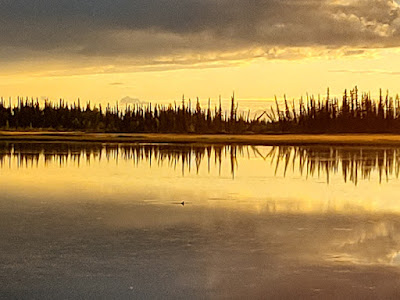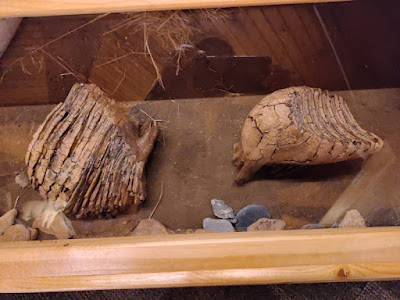We headed from Tok, Alaska to Whitehorse in the Yukon Territory of Canada.
We found a free lakeside campground along the way. We were the only ones here when we pulled in during the early afternoon. You can see YOLO in a nice flat spot next to the water in the background.Some puffball mushrooms I found in the campground.
Delicious.
The campground had a waterfowl viewing blind at one end. This is the view out the window of the blind. We watched a family of swans make their way across the lake.Looking down the lake. The calm waters reflected a nice afternoon sky.
The campground filled up fast in the late afternoon, and Jason found new folks to listen while he talked about building the van.
A beaver waddled into the water near us and swam away.
The evening glow at sunset with the trees reflected in the calm lake. Looks like a printout from a seismograph.
Jason sitting on the picnic table where the campers gathered to chat and share stories.
Calm reflections make pretty pictures in the evening light.
We got stopped for a construction project and had to wait for a pilot car to lead us through. The flag lady had heard about a bear in the area and had her rifle ready on the top of her car.
Wild mushrooms--King Bolete, shaggy mane and puff balls--on our cheeseburgers and bison burgers cooked over the fire at a picnic site.
The cache outside of the Northway visitor center. The ladies here invited us to a potlatch dinner in their village, but it was in the wrong direction so we declined.
Strawberry blight, a plant used for dyes by the Natives.
These poles are actually vents and were part of a failed experiment to try to keep the permafrost under the roadways from melting. We camped across the street.
Fireweed going to seed, the white fluffy plume on the left is a bunch of the seed pods caught on a filament and blowing in the wind.
A shaggy mane mushroom we ate later. A bag of lingonberries, too.
This fireweed is almost all seed fluff now.
Jason enjoying the free firewood in our fire ring at a government campground in the Yukon.
The stark mountain tops certainly looks like an old caldera from a volcano.
These dryas looked like snowballs on sticks and just shone so brightly in the sunlight.
Dryas and fireweed in front of a few trees along the bluff over the Duke River.
Close-up of some dryas. They hold onto that fluffy head even in strong winds.
Field of dryas along the roadside.
The bright red of the fireweed leaves and stems look pink when the light is diffused through the white fluff from their seed pods.
The town of Burwash Landing is just the museum next to the 'World's Largest Gold Pan'. The population of about 30 doesn't make much of a splash along the highway.
A garbage dump fire got out of control in high winds in 1999 and the town nearly burned to the ground. Firefighters were able to save the museum but it was close. This burned tree outside is an artistic reminder of the fire.
Inside the Kluane Museum of History was this moose hide boat. Two raw/untanned moose hides were stretched around spruce ribs and sealed with pitch and fat. The boat could go a couple of days before it had to be dried out. When the boat outlived its use of a couple of years, they could still tan the hide for other uses. Ingenious.
Hides and furs of all kinds were sewn together and beaded to make warm clothes.
Mastodon teeth. Many fossils and bones are found in the rivers of the region.
A good view of a musk ox inside the museum.
Wolverines are also in the area. Most people have never seen a live one, though.
This moose is looking right at you.
Our campground spot in the abandoned campground nearby. Lots of active bears in the area, we were told, so we kept our bear spray handy.
Jason pumped enough to get the water flowing in this old pump we found on the campground.
A rusted axe head was laying outside a log cabin we came across while walking around the campground area.
The Congdon Creek Campground not far down the road had been seeing a grizzly bear make an appearance daily. Our friends paid to stay there on the chance to see a bear. They did, just 10 minutes after we left them after taking this picture.
We camped at a large flat spot up a rocky road overlooking Kluane Lake.
A fireweed at the end of the season.
Autumn colors on an aspen branch on the hiking trail along the river next to our camp site.
Lake Kluane from our camp site on the hillside above the highway.
More shaggy mane mushrooms I had for dinner. They are good to eat as long as you get them before they go inky black and gooey.
The view over the flats next to the memorial to the builders of the Alaska Highway.
The plaque at the memorial.Jason looking for Dall Sheep on the hills by the visitor center at the memorial. The clouds were too low to see the tops of the mountains where the sheep hang out.
A memorial to the veterans on the top of the hill above the visitor center.
Wild sage I collected from along the path to the top of the memorial.
The memorial next to the flats by the visitor center. The flats used to be part of the lake, but a glacier blocked the flow of the water and the lake filled up and the water found an outlet at the other end. Now instead of a few miles flow to the Pacific Ocean, the water flows ten times as far to reach the Bering Sea. In 2016, the glacial melt water once again found a path to the Pacific and the Kluane Lake is no longer being fed that volume of water, so is now receding, creating more flats.
A carving of a Dall Sheep in marble at the visitor center on Kluane Lake.
The visitor center at Kluane Lake sits in front of sand flats that lead to the mountains behind. Hikers need permits to tackle the multi-day hikes from here.
The colors along the roadside are changing with the season.
A patch of bright red fireweed stands out in the scenery.
The tongue of a glacier in the distance through a rain shower.
The magenta of the fireweed blossoms and plants make the roadsides a flurry of color as we zoom by.
The bannock and caribou stew from the DaKu Cultural Center in Haines Junction. A local family was celebrating the return of some clothing items that had been purchased from them 50 years ago. The items were deemed of cultural value and the family was very glad to have them back and hosted the celebration with these native foods.
A white caribou hide dress with beaded fireweed.
Other dresses and outfits made by a graduating class of students at the cultural center, They were magnificent works of art and clothing.
Built from a Quonset hut, Our Lady of the Way Catholic Mission and church was the first church built on the Alaska Highway in 1954. It is kept open and still operational in Haines Junction.
Jason behind the altar in the church.
The pretty aquamarine water of Lake Kathleen. We went there looking for blueberries. We found every other kind of berry, but no blueberries. Some other local berry pickers were gathering moss berries (crow berries) and said we should go 75 miles south to find blueberries. View from our camp site along the Quill River. No berries, but a dynamite view and scenery on this rocky riverbed.
YOLO parked on the Quill River.
The dryas made the rocky riverbed look softer.
Fireweed in full seed mode.
A giant Amanita muscaria, or fly agaric mushroom we saw on our hike. It's bigger than my foot!
Jason doing dishes at the Quill River.
Our view out the back door along he river.
Jason relaxing along the Quill River.
Karen relaxing and catching a few rays along the Quill River. We really liked this spot and came back for a couple of days stay.
The pretty water of the Kusawa River from our campsite. This is a popular river for canoeists.
Looking upriver from our campsite on the Kusawa.
YOLO parked on our tiny little peninsula along the Kusawa River. The stream on the left fed into the river and we could see the different colored waters mix.
I like the colorful weeds here.

























.jpg)
















































No comments:
Post a Comment